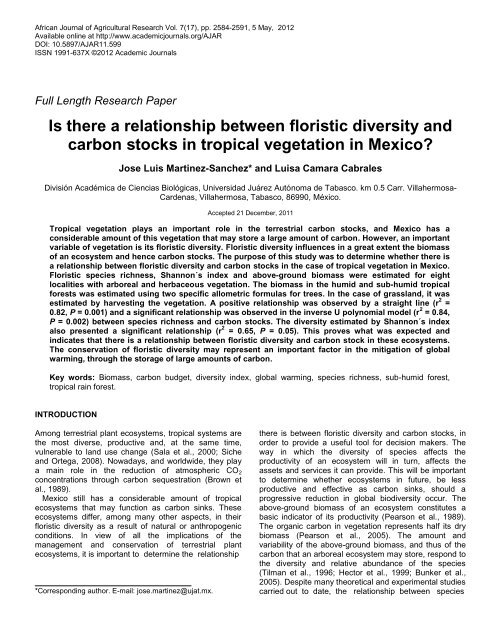Download Complete Issue - Academic Journals
Download Complete Issue - Academic Journals
Download Complete Issue - Academic Journals
You also want an ePaper? Increase the reach of your titles
YUMPU automatically turns print PDFs into web optimized ePapers that Google loves.
African Journal of Agricultural Research Vol. 7(17), pp. 2584-2591, 5 May, 2012<br />
Available online at http://www.academicjournals.org/AJAR<br />
DOI: 10.5897/AJAR11.599<br />
ISSN 1991-637X ©2012 <strong>Academic</strong> <strong>Journals</strong><br />
Full Length Research Paper<br />
Is there a relationship between floristic diversity and<br />
carbon stocks in tropical vegetation in Mexico?<br />
Jose Luis Martinez-Sanchez* and Luisa Camara Cabrales<br />
División Académica de Ciencias Biológicas, Universidad Juárez Autónoma de Tabasco. km 0.5 Carr. Villahermosa-<br />
Cardenas, Villahermosa, Tabasco, 86990, México.<br />
Accepted 21 December, 2011<br />
Tropical vegetation plays an important role in the terrestrial carbon stocks, and Mexico has a<br />
considerable amount of this vegetation that may store a large amount of carbon. However, an important<br />
variable of vegetation is its floristic diversity. Floristic diversity influences in a great extent the biomass<br />
of an ecosystem and hence carbon stocks. The purpose of this study was to determine whether there is<br />
a relationship between floristic diversity and carbon stocks in the case of tropical vegetation in Mexico.<br />
Floristic species richness, Shannon´s index and above-ground biomass were estimated for eight<br />
localities with arboreal and herbaceous vegetation. The biomass in the humid and sub-humid tropical<br />
forests was estimated using two specific allometric formulas for trees. In the case of grassland, it was<br />
estimated by harvesting the vegetation. A positive relationship was observed by a straight line (r 2 =<br />
0.82, P = 0.001) and a significant relationship was observed in the inverse U polynomial model (r 2 = 0.84,<br />
P = 0.002) between species richness and carbon stocks. The diversity estimated by Shannon´s index<br />
also presented a significant relationship (r 2 = 0.65, P = 0.05). This proves what was expected and<br />
indicates that there is a relationship between floristic diversity and carbon stock in these ecosystems.<br />
The conservation of floristic diversity may represent an important factor in the mitigation of global<br />
warming, through the storage of large amounts of carbon.<br />
Key words: Biomass, carbon budget, diversity index, global warming, species richness, sub-humid forest,<br />
tropical rain forest.<br />
INTRODUCTION<br />
Among terrestrial plant ecosystems, tropical systems are<br />
the most diverse, productive and, at the same time,<br />
vulnerable to land use change (Sala et al., 2000; Siche<br />
and Ortega, 2008). Nowadays, and worldwide, they play<br />
a main role in the reduction of atmospheric CO2<br />
concentrations through carbon sequestration (Brown et<br />
al., 1989).<br />
Mexico still has a considerable amount of tropical<br />
ecosystems that may function as carbon sinks. These<br />
ecosystems differ, among many other aspects, in their<br />
floristic diversity as a result of natural or anthropogenic<br />
conditions. In view of all the implications of the<br />
management and conservation of terrestrial plant<br />
ecosystems, it is important to determine the relationship<br />
*Corresponding author. E-mail: jose.martinez@ujat.mx.<br />
there is between floristic diversity and carbon stocks, in<br />
order to provide a useful tool for decision makers. The<br />
way in which the diversity of species affects the<br />
productivity of an ecosystem will in turn, affects the<br />
assets and services it can provide. This will be important<br />
to determine whether ecosystems in future, be less<br />
productive and effective as carbon sinks, should a<br />
progressive reduction in global biodiversity occur. The<br />
above-ground biomass of an ecosystem constitutes a<br />
basic indicator of its productivity (Pearson et al., 1989).<br />
The organic carbon in vegetation represents half its dry<br />
biomass (Pearson et al., 2005). The amount and<br />
variability of the above-ground biomass, and thus of the<br />
carbon that an arboreal ecosystem may store, respond to<br />
the diversity and relative abundance of the species<br />
(Tilman et al., 1996; Hector et al., 1999; Bunker et al.,<br />
2005). Despite many theoretical and experimental studies<br />
carried out to date, the relationship between species

















